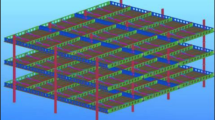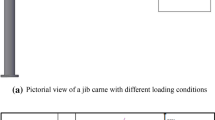Abstract
Functional configuration includes different fields in physical studies in the field of construction. In many of today’s structures, bodies are produced with a one-dimensional purpose (simply improving structural behavior or architectural performance and even addressing aesthetic considerations, etc.), which limits efficiency. Improvement of efficiency has been answered in a favorable way in nature. Many researches have been done in this regard, but specifically in the field of efficiency improvement with a structural approach based on the structure of the femur bone (one of the main components of the human body), as far as we know no study that is professionally reviewed and published by reliable organization has been done. This project aims to utilize structure-like features of femur bone and biomimicry principles leading to rising efficiency in cantilever structures. This investigation is an expansive applicable and descriptive-analytical simulative project. The data was collected by reviewing existing related materials in books, documentaries, and the internet. It explored the configuration of the femur bone while abstracting the load-resisting elements morphology in the hip area to achieve its finalized build. The unity of the concluded structure and hurricane geometry defined a bionic specimen modeled in the AutoCAD 2022 workspace. Structural loads were applied to conventional and bionic samples to compare their simulative sections in SAP 2000. It concluded that the figure’s designed structures based on the femur bone attribute significantly different compositions, besides obtaining optimum structural behavior. The amount of materials used in the bionic sample accounts for 25% less than the material used in the regular sample.






































Similar content being viewed by others
Data availability
Data sharing not applicable to this article as no datasets were generated or analyzed during the current study.
References
Golabchi M, Khorsandnikoo M (2014) Bionic architecture. University of Tehran, Tehran
Ashtari B, Yegane M, Daneshjoo K (2022) Contemplation on the potential of nature in developing inventive architectural concepts. Int J Archit Urb Dev 12(1):71–84
Taghizadeh K, Bastanfard M (2012) The anatomy of a human body, a model to design smart high building. Sci Technol 2(1):8–14
Mazzoleni I (2013) Architecture follows nature. CRC Press Taylor & Francis Group, London
Pedersen Zari M (2012) Ecosystem services analysis for the design of regenerative built environments. Build Res Inf 40(1):54–64
Xie YM, Steven GP (1997) Basic Evolutionary Structural Optimization. In: Evolutionary Structural Optimization. Springer, London. https://doi.org/10.1007/978-1-4471-0985-3_2
Shen Y, Liu Y (2021) Bioinspired building structural conceptual design by graphic static and layout optimization: a case study of human femur structure. J Asian Archit Build Eng 21(5):1762–1778
Moore F (1999) Understanding structures. WCB/McGraw Hill, Boston
Taghizadeh K (2007) Natural structures: lessons for architects. HONAR-HA-YE-ZIBA 28:75–84
BaniMasoud A (2007) A history of western architecture. KHAK, Esfahan
Genc O (2022) An assessment of transforming a city into a construction sector metabolism via industrial symbiosis implementations. Int J Civ Eng 20(12):1495–1514
Fatimah SA (2023) Antoni Gaudí: Nature & Geometry (Doctoral dissertation)
Macnab M (2011) Design by nature: using universal forms and principles in design. New Riders, California
Charles J (2004) Conversation of nature with nature. Archit Culture 5(17):64
Bhatia K, Hejib D (2018) Biomimicry: architecture follows nature. National seminar-PACE18, Maharashtra, India
Gruber P, Bruckner D, Hellmich C, Schmiedmayer HB, Stachelberger H, Gebeshuber IC (eds) (2011) Biomimetics—materials, structures and processes: examples, ideas and case Studies. Springer, Berlin
Collins P (1998) Changing ideals in modern architecture. McGill-Queen’s University Press-MQUP, London
Antoniades AC (1990) Poetics of architecture: theory of design. Van Nostrand Reinhold Company, New York
Farshad M, Firoozbakhsh K (1979) Bioengineering. Shiraz University Press, Shiraz
Ghafouripour A, Shemirani A, Tadayon M (2019) Bionic architecture in terms of relationship with structure and technology. In: proceedings of the second international conference on civil engineering, architecture and urban planning (in Persian)
Tavsan F, Sonmez E (2015) Biomimicry in furniture design. Procedia Soc Behav Sci 197:2285–2292. https://doi.org/10.1016/j.sbspro.2015.07.255
Genc O (2021) SymbioConstruction: a bibliography-driven dynamic construction industry symbiosis database. J Constr Eng Manag 147(8):04021077
Margoliu I (2003) Architects+ engineers= structures. Leonardo, 7
Heidarzadeh S, Mahdavinezhad M, Habib F (2023) Bio-inspiration from sponge for highperformance building. Naqshejahan-Basic Stud New Technol Archit Plan 13(3):86–101 (in Persian)
Ashtari B, Yeganeh M, Bemanian M, Daneshjoo K (2021) Nature-inspired architectural concepts for challenging spatial boundaries. J Environ Sci Stud 6(2):3757–3772
Chen Y, Chen L (1998) Fractal geometry. Earthquke Publisher, pp 5–7
Bonnemaison S (ed) (2019) Resurgence of organicism. Riverside Architectural Press Dalhousie Architectural Press
Nielsen F (2020) On Voronoi diagrams on the information-geometric Cauchy manifolds. Entropy 22(7):713. https://doi.org/10.3390/e22070713
Goharian A, Daneshjoo K, Mahdavinejad M, Yeganeh M (2022) Voronoi geometry for building facade to manage direct sunbeams. J Sustain Archit Civ Eng 31(2):109–124
Jongerius SR, Lentink D (2010) Structural analysis of a dragonfly wing. Exp Mech 50(9):1323–1334. https://doi.org/10.1007/s11340-010-9411-x
Skidmore, Owings, Merrill LLP (2011) Nature-structure. Structural efficiency through natural geometries. SOM Publishing Online, U.S.A
Dunlap RA (1997) The golden ratio and fibonacci numbers. World Scientific
Persaud D, O’Leary JP (2015) Fibonacci series, golden proportions, and the human biology. Austin J Surg HWCOM Fac Publ 2(5):1066
Akhtaruzzaman M, Shafie AA (2011) Geometrical substantiation of Phi, the golden ratio and the baroque of nature, architecture, design and engineering. Int J Arts 1(1):1–22
Sinha S (2017) The fibonacci numbers and its amazing applications. Int J Eng Sci Invent 6(9):7–14
Gharooni F, Omrani Pour A, Yazdi M (2014) Bionic architectural design, case study the design of architectural shells with the inspiration of Abalon Pearl. Armanshahr Archit Urb Dev 6(11):127–140
Sarkisian M (2011) Nature structure: structural efficiency through natural geometries. Skidmore, Owings and Merrill, London
Audibert C, Chaves-Jacob J, Linares JM, Lopez QA (2018) Bio-inspired method based on bone architecture to optimize the structure of mechanical workspieces. Mater Des 160:708–717. https://doi.org/10.1016/j.matdes.2018.10.013
Jang IG, Kim IY (2008) Computational study of Wolff’s law with trabecular architecture in the human proximal femur using topology optimization. J Biomech 41(11):2353–2361
Rahman K, Helil N, Imin R, Geni M (2013) A new bionic topology optimization method based model of bone adaptation. Appl Mech Mater 433:2254–2259
Gao C, Peng S, Feng P, Shuai C (2017) Bone biomaterials and interactions with stem cells. Bone Res 5(1):1–33
Maghsoudi-Ganjeh M, Lin L, Wang X, Zeng X (2019) Computational investigation of ultrastructural behavior of bone using a cohesive finite element approach. Biomech Model Mechanobiol 18(2):463–478
Maghsoudi-Ganjeh M, Lin L, Wang X, Zeng X (2019) Bioinspired design of hybrid composite materials. Int J Smart Nano Mater 10(1):90–105
Maghsoudi-Ganjeh M (2020) Computational investigation of ultrastructural behavior of bone and bone-inspired materials. The University of Texas at San Antonio, San Antonio
Maghsoudi-Ganjeh M, Samuel J, Ahsan AS, Wang X, Zeng X (2021) Intrafibrillar mineralization deficiency and osteogenesis imperfecta mouse bone fragility. J Mech Behav Biomed Mater 117:104377. https://doi.org/10.1016/j.jmbbm.2021.104377
Buccino F, Aiazzi I, Casto A, Liu B, Sbarra MC, Ziarelli G, Vergani LM, Bagherifard S (2021) Down to the bone: a novel bio-inspired design concept. Materials 14(15):4226. https://doi.org/10.3390/ma14154226
Meyer GH (1867) Die architektur der spongiosa, archief fur den anatomischen und physiologischen. Wissenschaften im Medicin 27(4):1389–1394
Wolff J (1892) Das Gesetz der Transformation der Knochen, Berlin, A. Hirchwild. (translated as ’the law of bone remodeling’ by P. Maquet and R. Furlong, 1986, Springer, Berlin)
Frost HM (2000) The Utah paradigm of skeletal physiology: an overview of its insights for bone, cartilage and collagenous tissue organs. J Bone Miner Metabol 18(6):305–316. https://doi.org/10.1007/s007740070001
Huiskes R, Ruimerman R, Van Lenthe GH, Janssen JD (2000) Effects of mechanical forces on maintenance and adaptation of form in trabecular bone. Nature 405(6787):704–706. https://doi.org/10.1038/35015116
Tezuka KI, Wada Y, Kikuchi M (2003) iBone: a reaction diffusion based shape optimization method. Key Eng Mater 243–244:601–606. https://doi.org/10.4028/www.scientific.net/kem.243-244.601
Fernandez Torreiles A (2011) Gaudi. Via university college, pp 10–13
Sanyal A, Gupta A, Bayraktar HH, Kwon RY, Keaveny TM (2012) Shear strength behavior of human trabecular bone. J Biomech 45(15):2513–2519
Launey ME, Buehler MJ, Ritchie RO (2010) On the mechanistic origins of toughness in bone. Annu Rev Mater Res 40:25–53
Ulstrup AK (2008) Biomechanical concepts of fracture healing in weight-bearing long bones. Acta Orthop Belg 74(3):291–302
Upadhayay A, Maru S (2022) A review of the fractal geometry in structural elements. Int J Adv Eng Res Sci 8(7):025–035
Keyvan Bahari M, Farahmand F (2007) Modeling of proximal femoral bone renovation process using level set method. In: 14th iranian medical engineering conference, Tehran (in Persian)
Esteki A, Skeleton—muscular textbook, University of Medical Sciences and Health Services Shahid Beheshti University of Medical Sciences, 56 (in Persian)
Frizziero L, Santi GM, Leon-Cardenas C, Donnici G, Liverani A, Papaleo P et al (2021) In-house, fast FDM prototyping of a custom cutting guide for a lower-risk pediatric femoral osteotomy. Bioengineering 8(6):71. https://doi.org/10.3390/bioengineering8060071
Jalali A, Golabchi M (2018) Sustainable prefabricated structure design by salt sediment inspired by material distribution optimization of human trabecular bone. Hoviatshahr 12(33):5–12
Nanavazadeh S (1398) Analysis of proximal femoral bone stress and comparison of bone fracture risk in young and old women prone to osteoporosis based on CT scan images. In: the first international conference on new strategies in engineering, information science and technology in the next century (in Persian)
Wolff J (1986) The internal architecture of normal bone and its mathematical significance. The law of bone remodelling. Springer, Berlin
Zahrai SM, Heisami A (2017) Modeling impact damper in building frames using GAP element. J Struct Constr Eng 4(1):113–125
Ardekani A, Golabchi M, Hosseini SM, Alaghmandan M (2017) Investigation of the impact of high-rise buildings shapes on their structural stability in order to reduce seismic hazards (case study: the effect of shape of plan). Environ Manag Hazards 4(1):27–42
Beer F, Johnston E, Mazurek D (2012) EBOOK: vector mechanics for engineers: statics (SI Units). McGraw Hill
Mazzoni S, Mckenna F, Scott MH, Fenves GL (2006) OpenSEES command language manual. Pacific earthquake engineering center. University of California, Berkeley
McKenna F, Fenves GL (2001) The OpenSees command language manual. Pacific earthquake engineering center. University of California, Berkeley
Saghafi MH, Golafshar A, Zareian MS, Kashani M (2020) The effect of high-performance fiber-reinforced cementitious composites on the lateral behavior of reinforced concrete frames without seismic details. Structures 26(11):801–813
Hosseini SM, Kenarangi H, Fanaei N (2015) Application of OpenSees software in modeling and structural analysis. Azadeh Publications (in Persian)
RahatDahmardeh S, Motamedi M, AzimiNejad A (2020) Investigating the adequacy of accidental eccentricity recommended by seismic design codes to consider the effects of earthquake rotational components in nonlinear dynamic analysis. Modares Civ Eng J 20(4):91–106
Salvadori MG, Heller RA (2014) Structure in architecture: the building of buildings traslated by M Golabchi, 13th edn. University of Tehran, Tehran
Noghrekar A, Jahanbakhsh H, Hamzenajad M (2017) Man, nature, architecture. Payam Noor University Publications, Tehran, 184
Acknowledgements
This study was supported by Tarbiat-modares University. The authors appreciate their kind support. First author is also grateful for the efforts of his respected colleague Mr. Engineer Mohammad Hossein Mohammadi, Senior Earthquake Civil Engineer, who cooperated with him in the structural modeling stages.
Funding
The authors declare that no funds, grants, or other support were received during the preparation of this manuscript.
Author information
Authors and Affiliations
Corresponding author
Ethics declarations
Conflict of interest
On behalf of all authors, the corresponding author states that there is no conflict of interest.
Ethical approval
This article does not contain any studies with human participants or animals performed by any of the authors.
Informed consent
For this type of study formal consent is not required.
Rights and permissions
Springer Nature or its licensor (e.g. a society or other partner) holds exclusive rights to this article under a publishing agreement with the author(s) or other rightsholder(s); author self-archiving of the accepted manuscript version of this article is solely governed by the terms of such publishing agreement and applicable law.
About this article
Cite this article
Nouri, A., Zarkesh, A. Efficient configuration in architectural structures based on biomimicry principles in femur bone using hurricane geometry. Innov. Infrastruct. Solut. 9, 53 (2024). https://doi.org/10.1007/s41062-023-01348-7
Received:
Accepted:
Published:
DOI: https://doi.org/10.1007/s41062-023-01348-7




